Programs Blog
Music, Men o’ War, and Midwater Fish

Date: April 30, 2025
Time: 0930
Location: Central South Pacific Gyre, within French Polynesian waters
Weather: 21° C,Sunny
High winds sometimes make for rough seas, but they also make for fast sailing. All the experienced sailors on board keep telling us that four or five knots is a normal pace, but we keep screaming along at seven or eight.
This is Ana, writing to you from the tropics, as of yesterday when we passed 23.5˚ south latitude. The weather seems to have noticed that we’re in the tropics, too, so a bunch of us spent some time on deck enjoying the sun and puffy clouds and blue water. The hour that I had blocked out for writing this post turned into the second hour spent on deck learning new guitar skills and jamming with Zach and Satya. Whoops. (See the photo in Charlotte’s next blog post; I’m about to grab a guitar and join about three minutes after this picture was taken.)
As we continue north towards Tahiti, we’re moving through different regions of the South Pacific Gyre. We’ve been sampling the critters along the way with both our neuston and meter nets, used for surface and deeper water animals respectively. I get to write about some of the standouts.
The largest thing we’ve brought in with the neuston net so far has been a few sizeable Physalia sp., better known as the Portuguese Man ‘o War (and in case you’re wondering, nobody has been stung this trip, in part due to the valiant efforts of our first Marine Tech, Matt, and his skilled use of a bucket during our swim call. But anyway…). Although we often call them jellyfish, they’re actually a closely related group called Hydrozoans. It gets weirder though, because what we think of as one animal is actually a colony of genetic clones that each specialize in something. The float/sail is one polyp, or individual; the tentacles are a bunch more; and the reproductive structure another.
The meter net brings in all kinds of interesting creatures. We usually deploy the meter net at night, when animals from the deep migrate up towards the surface to eat. That means we often catch animals that spend most of the life in the deep, and all of their life in the dark. A couple days ago we caught a loosejaw stoplight fish. Most of the life in the midwater bioluminesces in one form or another, but the stoplight fish has developed a particularly neat use for it. Because red light is completely absorbed by about 15-feet of sea water (if you know any scuba divers they can attest to this), most midwater and deep water animals can’t see red. The stoplight fish, however, can. It has a light organ below its eye that makes red light, so it has a flashlight that its prey can’t see. That adaptation has inspired some red-light deep-sea cameras that have powered all kinds of incredible discoveries, including the first video of a giant squid in its natural habitat.
We’ve found all kinds of other cool critters, from flying fish to free swimming snails to juvenile squid and so much more, and we’ll keep finding new interesting things as we move towards warmer coastal waters. But those creature features will have to wait for another day.
Shout outs:
Mom and Dad: This whole thing has been a bit of a wild ride, but I’m glad I’m here. Thanks for teaching me to be adventurous and supporting and encouraging my expeditions since.
Ava: You made me promise to have fun, and I am. I also miss you like crazy. I’ve got all kinds of stories to tell you and I can’t wait to hear what you’ve been up to. I’ll talk to you soon.
To everybody I love: You’re going to be real sick of some of my boat stories in a couple months. Get ready.

Recent Posts from the Ships
- Ocean Classroom 2024-A collaborative high school program with Proctor Academy
- Collaborations and Long-term Commitments: SEA’s Caribbean Reef Program Sets a Course for Coastal Programs that Compliment Shipboard Experiences.
- Sea Education Association students prepare for life underway using state of the art nautical simulation from Wartsila Corporation.
- SEA Writer 2022, Magazines From the Summer SEA Quest Students
- Technology@SEA: Upgrades Allow Insight into Ocean Depths
Programs
- Gap Year
- Ocean Exploration
- High School
- Science at SEA
- SEA Expedition
- SEAScape
- Pre-College
- Proctor Ocean Classroom
- Protecting the Phoenix Islands
- SPICE
- Stanford@SEA
- Undergraduate
- Climate and Society
- Climate Change and Coastal Resilience
- Coral Reef Conservation
- Marine Biodiversity and Conservation
- MBL
- Ocean Exploration: Plastics
- Ocean Policy: Marine Protected Areas
- Oceans and Climate
- Pacific Reef Expedition
- The Global Ocean: Hawai'i
- The Global Ocean: New Zealand